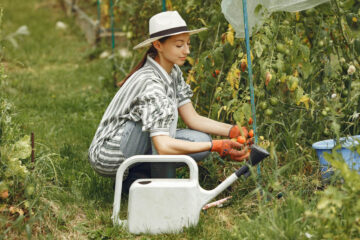Fourteen years ago, Stephanie and Joel lit candles because they had no power. They wore snow suits indoors because the home they were building had holes in the walls. They salvaged scraps from the dump to raise its frame, with no blueprint and no real plan—just a shared belief that they could figure it out.
Today, Stephanie and Joel wake up in a home they built with their own hands. Morning coffee simmers on the wood cookstove while sunlight pours into the greenhouse sunroom, where tomatoes climb toward LED grow lights. Their life off the grid isn’t about escape—it’s about deep connection. To the land. To each other. And to the raw, sometimes ridiculous, beauty of self-reliance.
This is the story of how they built it all, one salvaged piece at a time.

They started with an outhouse.
That was the first structure. Then came a small workshop with just a few tools. The main cabin followed—post and beam, rough and rustic—built almost entirely from salvaged materials. Lumber came from a crumbling barn and scraps from demolition projects. They pulled wood from the local dump and took whatever was free or cheap. If it looked even remotely usable, they found a way to make it work.
The first winter, there were still gaps in the walls. Heat came from a single wood stove, and they wore their snow suits inside until the room finally warmed up. That was their rhythm: get cold, build a fire, wait. Eventually, they saved enough for one solar panel and a marine battery. Lights turned on. That moment felt like magic.
Over time, they expanded the system. Today, they run their home on five solar panels, 400 amp-hour lithium batteries, and a quiet Honda generator to fill in the gaps during gloomy winter stretches. Everything evolved slowly—nothing overnight, everything earned.
They didn’t just build a house—they created a home.
The cabin has a master bedroom in the loft and a split sleeping space on the main floor for the kids. The central living space is open-concept: kitchen, dining, and living room all flow together. A bottle wall encloses the bathroom, casting beautiful light when the sun hits just right. Their favorite addition is the sunroom—warm in the winter, shaded in the summer, and bursting with food year-round thanks to LED grow lights.
Heat comes from a wood cookstove in the winter, but they added a propane thermostat-controlled stove to keep things comfortable through the night. With kids in the house, nobody wants to wake up freezing at 3 a.m.—especially not when little ones are grumbling about the cold. The propane stove lets them sleep through, and still wake up warm.
Their water setup is just as inventive. They pump water from a nearby quarry to a loft reservoir, where gravity feeds it through the home. To prevent freezing in winter, they raised the tank to the warmest part of the house. A propane on-demand water heater now powers their shower, and their drinking water comes from a well. For the toilet, they use a composting unit and still keep the original outhouse in use—because yes, they genuinely love it. It’s quiet. You can leave the door open and watch the birds.
They do more than just survive—they thrive.
This family grows nearly all of their food. Eggs, meat birds, fruits, vegetables, even mushrooms—it’s all here. They inoculate logs for gourmet mushroom production, make wine from grapes, harvest honey, and fill their pantry with the bounty from three communal gardens. They grow corn, squash, potatoes, cucumbers, tomatoes, and peppers. They’re also avid foragers, learning the local plants, medicinals, herbs, and fungi—building a knowledge base they’re eager to share through future workshops.
They don’t live off-grid in isolation either. Community plays a huge role. They share the land, share food, and support each other. One of them runs a tree service, which helps fund the homestead, and together they opened a small off-grid Airbnb to welcome guests who want a taste of this lifestyle. Even their daughter is getting in on the action—Alice May’s Lemonade Stand is her first small business venture, teaching her about self-employment and the value of money earned the hard way.

It isn’t always easy, but it’s always worth it.
Stuff breaks. Water pumps fail. Panels underperform. They argue sometimes. Troubleshoot daily. But through it all, there’s this deep, steady satisfaction: they built this life. When things fall apart, they fix them. When things work, they celebrate. And when they look around—at the land, the food, the light, the warmth—they feel something bigger than comfort.
They feel gratitude.
That’s the real foundation of their life. Not the wood, solar, or even the land—but the daily, quiet appreciation for what they’ve built. For what they’ve learned. For the freedom that comes from figuring it out themselves.
This lifestyle isn’t glamorous. Simple living rarely is. But it’s honest, and full, and rich in the ways that truly matter.
They built their home from the dump. But they built their life from love, sweat, stubbornness, and the joy of learning every single day. And they wouldn’t trade it for anything.





[…] for power. They are currently saving up for a solar power array so that they can use it completely off the grid. They also plan on painting the exterior as soon as funds allow […]